Slaughterball: Neuer Kickstarter
Das nächste Ballsport-Brettspiel sucht Kunden.
A board game of brutal future sports mayhem for 2-4 players with smooth rules, sizzling art, choice components, and beefy miniatures!
Slaughterball ist ein brutaler Ballsport in der Zukunft. Teams versuchen den Ball in das gegnerische Tor zu bugsieren und auf dem Weg noch dein ein oder anderen Gegenspieler von den Füßen zu holen.
Das Spiel ist für 2-4 Spieler geeignet.
Der Pledge mit dem Spiel kostet 100$, inklusive Kickstarter exklusiven Figuren. Der Butcher Pledge, der alle kostenlosen Streatchgoals enthält kostet regulär 150$, im noch erhältlichen Early Bird 145$.
Der Versand ist leider recht hoch, für Europa liegt er bei 57$.
Slaughterball comes with the following quality components:
27″ double-sided game board — one side has the Octagon for 2- or 4-team games, while the other side has the Hexagon for 3-team games
52 plastic athletes
70 strategy cards
20 custom 6-sided dice (engraved, 16mm, 10 white, 10 black)
1 standard 8-sided scatter die (16mm)
2 plastic balls
A slew of card tokens
4 scrimmage athlete reference cards (double-sided)
4 pro team reference cards (double-sided)
4 maverick reference cards (double-sided)
Rulebook
Wer mehr über den Inhalt der Box und das Gameplay erfahren will, findet in den Kampagnen-Updates Videos dazu.
Das Ziel der Kampagne liegt bei 40.000$, derzeit sind 17.000$ erreicht. Bis zum 17. März bleibt noch, um die benötigte Summe zusammen zu bekommen.


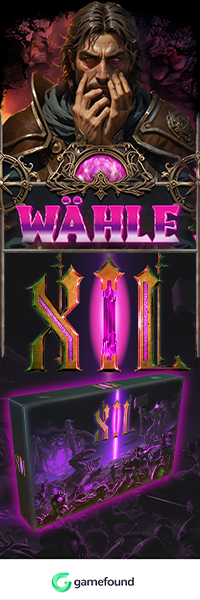
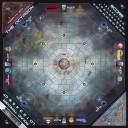
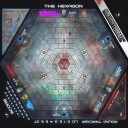

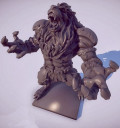


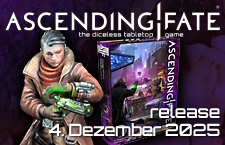
Die Optik von dem Ding sieht wirklich seeeehr stylisch aus.
Auf der offiziellen internetseite kann man auch nett gemachten nerdigen fluff zu jedem Spieler lesen.
Als Ami hätte ich da vermutlich sofort zugeschlagen 🙂
Ich habe die mal angeschrieben, ob sich da irgendwas wenigstens mit EU-Distributor oä was noch tut, das entweder hohe Portokosten ODER Zoll auf einen zukommt.
Beides zusammen ist echt mal ne Ansage (gerade wenn KS wie Journey bei vermutlich ähnlichen Paketgewicht und Größe auf 30$ kommen UND EU-Import macht)
Wenn eine Antwort kommen sollte, gebe ich die an auch weiter.
Auf jeden Fall cool, aber vielleicht doch eher was das man später mal im Laden kauft. Muss ja nicht immer Kickstarter sein 😉
Figuren und das Board gefallen mir besser als Dreadball aber DB gibt es nunmal schon und wird auch schon fleißig gespielt, also warum noch ein weiteres Future-Ballspiel holen?
Hi,
das Spiel läuft ja noch nicht lange und bis zum Ende kann sich noch einiges tun. Natürlich gibt es Dreadball, aber es gibt auch Bloodbowl und viele Spiele haben ähnliche Themen, aber trotzdem sind sie anders. Slaughterball hat zum Beispiel eine Variante für 3 und 4 Spieler, sodass man mit mehreren Freunden spielen kann und es sind auch keine Fantasyrassen, sondern genetisch veränderte Spieler.
DreadBall hat auch Mehrspielervarianten.
Auch sind die Spieler bei DreadBall auch nicht nur Fantasyrassen, sondern es gibt 2 Menschenteams.
@ Magua: Ok, das mit den Mehrspielervarianten wusste ich nicht. Ändert aber nichts daran, dass auch dieses Spiel seine Daseinsberechtigung hat und anders ist als Dreadball.
In meinen Augen hat so ziemlich jedes Spiel seine Daseinsberechtigung, mir würde aus dem Stand nichts einfallen, was ich für komplett überflüssig halte.
Slaughterball zielt sicher auf dieselbe Zielgruppe wie Dreadball, und auch einige Designs kommen mir bekannt vor (der Ball hat halt eine Leuchtlinie weniger), aber ich denke einfach mal, dass es im Zweifelsfall hoffentlich genug Alleinstellungsmerkmale aufweist.
Ich würde mal sagen Slaughterball zählt auch eher auf reine Brettspieler ab und DreadBall mehr auf Tabletop Spieler. Werde mir DreadBall aber auch mal zu Gemüte führen.
Da hast du recht Christian, mir ist bis jetzt auch noch keins vorgenommen. Nur Spiele die langweilig waren.
Hoffe der Text ist für euch Interessant. Zitiert von boardgamegeek.com
Talisinbear wrote:
I cut my teeth on Bloodbowl and loved it.
But Dreadball eclipsed BB which it should when you have a game to sort of improve on, and DB is just better.
What I am curious about is how does Slaughterball differ from DB? What does it offer that makes it different enough to play?
Here’s a long answer to your question about the differences between Slaughterball and Dreadball. Even though it’s long, it doesn’t list all the differences. Even though SB and DB both are about futuristic sports, there are more differences than similarities. I’ve listed the differences that I think matter most.
Of course, I’m biased toward my own game, so you’ll have to take my comments below with a grain of salt. I don’t want to demean Dreadball in any way, because it is a fine game. I just like my game more. But that is hardly surprising. You can obviously disagree with what I consider to be “better”, and I totally get that. But, if you find yourself agreeing with me, I’d ask that you please consider backing Slaughterball. I’d love to get to some higher stretch goals that unlock more teams, mavericks, mascots, and cheerleaders. And I can’t do that without your help.
COMPONENT DIFFERENCES
1. No assembly required with Slaughterball. Assembly is required with Dreadball.
2. Slaughterball comes with a double-sided game board that is twice the size of DB’s board. You get 2 arenas instead of one. Plus, IMO, the SB artwork is more detailed and atmospheric.
3. Slaughterball comes with 20 16mm custom dice as opposed to DB’s 18 12mm standard (pip) dice. SB also has a 16mm d8 scatter die.
4. Slaughterball comes with 52 athletes (4 teams + 4 mavericks) at pledge goal $40,000. That’s enough to field any roster allowed by the scrimmage, exhibition, and league rules. I think DB’s Kickstarter was up to around $500,000 before it reached 50 figs. If someone wants to go do the calculations and confirm that, I will of course change this number.
5. Larger athletes. Personally, I found the Dreadball miniatures too small. I understand that their 28mm scale is a historic standard. But I just think 28mm is too tiny. When my Carnage butcher lumbers across the pit to brutalize some hapless Nemesis cleaver, I want him to feel like a monster! With Slaughterball minis, that’s exactly what it feels like. If you only want extra miniatures for your other sports games, then you probably don’t want to use most Slaughterball miniatures. You can use some as larger athletes for other games, but most probably won’t translate. I can’t post direct size comparisons unless Mantic gives me permission to publish images of their miniatures.
GAMEPLAY DIFFERENCES
1. In Slaughterball, you can score points for injuring opponents. You get 1 point for each opponent you knock down, and up to 4 points for each opponent you send to the injury box. I really enjoy this part, and it gives coaches two different paths to victory. You can try to slaughter your opponents, which weakens them and scores you points. Or you can avoid your opponents and go for a shooting game. Or you can do a mix. Great way to provide more options to coaches.
2. From the very beginning, Slaughterball was designed to support 2-4 teams in a game. It fully and elegantly supports 2, 3, or 4-team games right out of the box. Multi-team games are an integral part of the sport.
3. Slaughterball athletes are not limited to what actions they can perform. All athletes can pick up the ball, pass it, shoot goals, spike opponents, and chop opponents. Each type of athlete is better at some things than others, but no rules restrict who can throw and who can chop, etc. Again, more options for coaches.
4. More streamlined action resolution. Instead of rolling 3 standard 6-sided dice and comparing the results to something like „3 dice Speed test (123)“, Slaughterball has you roll dice equal to your trait and count the knives. The dice have custom symbols. All you have to do is count up the number of knives you roll to determine how successful you are. For example, when your athlete chops an opponent, both you and the opponent roll a number of dice equal to Brawling. Whoever gets the most knives knocks down the other. To me, this is more streamlined and easier to remember. Skills enable athletes to use other symbols on the dice.
5. More robust risk-based scoring. In Slaughterball, when you shoot a goal you score a number of points equal to the shooter’s distance from the goal. You can go for an easy 1-point shot if you’re adjacent to the goal. You can go for a Hail Mary shot from 10 spaces away if your shooter is good enough. And you can try for anything in between, or even beyond. Coaches have complete freedom to decide exactly how much risk they want to take when scoring goals. More options for coaches once again. This has resulted in some epic wins in playtesting as an athlete snatched victory from the jaws of defeat by risking that long shot in the last seconds of a game. UPDATE: Forgot to mention that any team can score in any goal.
6. No facing requirements. Slaughterball assumes that the athletes are in constant motion, always running, turning, scanning the pit. After all, they are genetically engineered super athletes. They should be very good at observation. This equates to no „facing“ rules. That is, it doesn’t matter which way the plastic playing piece is facing. I’ve found this speeds play. (There are some strategy cards that can simulate blindside hits, such as Unexpected Spike or even Brute.)
7. No referee piece is on the board. Slaughterball referees are abstracted into the strategy card deck with Penalty cards. Whenever an athlete commits a foul, any coach can play a Penalty card to send that athlete to the Penalty Box. This speeds play, while maintaining that “will the ref see this”? tension, because you never know if your opponents have a Penalty card in their hands. However, if you like having a refbot on the field, then you probably won’t like this.
8. In my opinion, the differences above give SB coaches more options and fewer restrictions than DB.
That’s a list of some of the differences between SB and DB. It’ll just be a matter of opinion for you on which differences you prefer. For me, I think the SB rules result in an easier, speedier, more exciting game. But that’s just me.
I’m obviously way behind Mantic as far as adoption and reputation, and I don’t have a company of coworkers to help me. That’s why I have to work hard to convince you about Slaughterball. That’s why I decided to give you 52 athletes at the $40,000 goal. It’s more expensive for me, but I need to provide you with obvious value right from the start. Over the course of the Kickstarter I will do my best to convince you that Slaughterball is a great game. If you pledge $1 you’ll get all the updates and info about the game as we go along. You can also check out http://www.slaughterball.net to find out a lot more about the game.
And please ask questions if you have them. That’s one of the ways I can make you as informed as possible so you can make a good decision about pledging for Slaughterball.
Thanks a lot for taking the time to read this!
Erik Kjerland
Designer of Slaughterball
Interessant, aber in meinen Augen auch ein wenig zwiespältig.
Die ersten Unterschiede lasse ich mal außen vor, da sie die Komponenten betreffen und in meinen Augen Geschmackssache sind (und nur die Zahl/das Design der Würfel macht in meinen Augen noch nicht wirklich eine besondere Qualität aus).
Was das Gameplay angeht:
Da klingt Slaughterball ein ganzes Stück simpler, weil viele Restriktionen/Komponenten, die bei Dreadball eine wichtige Rolle spielen, wegfallen. Der bewegliche Schiedsrichter (der ja auch bei Dreadball nur eine Hälfte des Penalty-Systems ist) ist beispielsweise etwas, das mir wirklich Spaß macht und taktische Optionen bietet.
Auch Dinge wie „Ausrichtung spielt keine Rolle“, „Jeder Spieler kann im Grunde jede Aktion durchführen“ und „Deutlich vereinfachte Würfelproben“ (und die von Dreadball sind schon ziemlich vereinfacht) stimmen mich eher skeptisch Das Ganze führt natürlich zu einem schnelleren und unkomplizierteren Spiel, aber ob es auch zu mehr Taktik führt? Man müsste das Ganze mal testen, für mich klingt Slaughterball aber nach einem lockeren Brett-Sportspiel, das einen noch deutlicheren „Bier und Bretzel“-Charakter hat als Dreadball.
Naja, ich mag Dreadball halt sehr, und bin deshalb vielleicht voreingenommen, aber für mich klingt Slaughterball eher nach einer „Light“-Version, die sich an eine etwas andere Zielgruppe richtet.
Könnte aber trotzdem spaßig sein. 🙂
Ich glaube das ist ein allgemeiner Diskussionspunkt, bei dem jeder selbst entscheiden muss, ob das wirklich gewollt ist – wieviel taktische Tiefe ist die richtige Tiefe? Will ich spielen, oder möglichst vie debattieren und fachsimpeln wie Regeln angewendet und möglichst effizient ausgenutzt werden?
Es gibt ja zahlreiche Spiele die (natürlich nur in meinen Augen) durch ein zu komplexes Regelsystem dazu führen, dass manche Produkte zu diesen Spielen gar nicht verwendet werden. Ad hoc könnt man jetzt die Man o` War bei der Khadorfraktion in Warmachine nennen, oder Schwarzorks bei Orks und Goblins im Warhammer Fantasy Spiel.
Ist ein Team beispielsweise besonders gut, führt es dazu, dass andere Teams wenig, oder gar nicht gespielt werden.
Also wenn ich sehe, das anscheinend doch zumindest ein Grundinteresse für das Spiel da ist, sollte sich der Hersteller wirklich um einen EU-Import kümmern.
Ich geb zu, das ich keine Ahnung habe, was das kostest bzw ab wann sich das rechnet, aber ich glaube mit dieser extremen Superhelden Comic Look hat das Spiel wirklich ein genug eigenständiges Profil, um auch in Europa sich gut zu verkaufen.
Mit dem EU-Import wären dann auch dieser Doppelte Grundbox zu den selben Versandkosten wieder interessant.
Dann wären es nämlich knapp 30$ für 2 backer und halt auch keine MwST und Zollgebühr (über150€)
Müsste man sich dafür nicht nur mit einem anderen Spieler hier in Deutschland zusammen tun? Dann wären doch die Versandkosten bereits halbiert.
Was meinst du mit „keine MwST und Zollgebühr (über150€)“?
Die Gebühren fallen erst ab einem gewissen Warenwert an, in den die Versandkosten allerdings reingerechnet werden.
Genau, die „Alles Doppelt“ Variante halbiert wirklich das Porto (man muß aber ggf innerdeutsches Porto trotzdem dazurechnen, wenn dein Backer-Partner nicht in derselben Gegend wohnt).
Dafür bis du aber über den Grenzbetrag wie Christian schon gesagt hat und dann kann man grob mit einem 25% Aufschlag auf den Pledge UND dem Porto rechnen. 19% MwSt und die Zollgebühr je nach Gegenstand. Das liegt oft im Ermessen des Zollbeamten, aber Plastikfiguren bzw Gesellschaftspiele liegen so ca bei 5-6%
Ich liebe komplexe Spiele, aber davon habe ich schon genug. Mit der „Light“ Version stimme ich dir zu. Das macht es für mich aber auch interessant. Ich muss nicht viel aufbauen, ich muss vor allem auch keine Miniaturen anmalen (dann würde ich eher Mitspieler vertreiben ^^) und das Spiel scheint unkompliziert zu sein. Mit einer Erweiterung könnte man dann auch weitere Regeln und komplexere Mechanismen ergänzen oder man macht Hausregeln. Das mit dem “Jeder Spieler kann im Grunde jede Aktion durchführen” wurde auch schon angesprochen, behagt mir derzeit auch nicht, aber zum Glück kann sich da noch einiges ändern. Das ist das schöne an Crowdfunding.
Ich habe ne Antwort von dem Designer bekommen:
I just sent Journey folks an email asking how they arranged their EU shipping. Hopefully they’ll respond with some good info. I’ve already subsidized $10 of the international shipping, and even more for the DOUBLE BUTCHER
Klingt schon mal gut, das er anscheinend da wirklich an Lösungen interssiert ist.
Mal sehen, er hat ja noch genügend Zeit